
Greenhouses are an ideal set up for growing orchids. They allow you to control environmental factors like temperature, humidity, and air flow. Since these factors are crucial with orchids, greenhouses can be quite appealing to orchid growers. However what type of greenhouse should you use? There are many options, and the correct answer depends on several factors.
The materials used will depend on what kind of climate you live in. Most greenhouse covers are suitable for blocking against cold and strong winds depending on the framework of the greenhouse, but not all of them work with every climate.
In the hot zones, your biggest problem will probably be cold nights, humidity, and water retention. These conditions will do very well with fabric greenhouse covers, which are able to keep temperatures optimal without creating an environment that is too hot in the greenhouse.
Plastics and polyfiber sheets are also ideal, though expensive. They can easily control the weather. In cold climates, films will create excellent heat retention – the thicker the better. The tropical and the Mediterranean climates will allow most covers to be used, including polyethylene and fabric.
Glass is not ideal in very cold climates as it easily loses heat. It is, however, ideal in climates with warm nights and hot days.
The best greenhouse covering for orchids should consider the amount of light coming in, water retention and heat retention. All these will affect the humidity of the greenhouse at the end of the day. The covering should be durable and able to last for a long time. Cheap and weak materials will get torn or damaged, compromising the integrity of the greenhouse. The best covering should cut across the climatic needs of the orchids and allow control at the same time.
This means that the conditions in the greenhouse should be easily manipulated despite the type of covering. This will also depend on the type of mechanism integrated into the greenhouse. Most small greenhouses are manually operated but some do use remotely controlled openings and greenhouse controls.
Growing orchids in Africa in greenhouses, especially in Kenya, is booming business. Because of the affordability and functionality, the most favorable greenhouse cover material in the region is polyethylene films. These films come in different thicknesses depending on the budget and the needs of the buyer. The thickness affects durability and heat retention. The thicker they are the stronger and more durable. They will also retain more heat. The fact that the region has optimal temperatures makes this concern less risky. The fact is that the flowers are rare, yet the climate is favorable. Greenhouses in the region are used more to stop cold winds than for favorable temperatures. Being an equatorial region, temperatures will always be at optimum for the growth of orchids.
The biggest risk in any greenhouse is disease and water. The film is perfect for retaining water and keeping a suitable humid condition, being about 40% to 60% for optimal growth. The film can also withstand heavy winds and keep out unwanted chills, creating a more favorable climate.
The fabrics are also usable, they are more expensive, but will give the same results as the films. The fabrics are basically woven plastics that are tough and durable. They are mostly affected by cold winds, weather, and lack of water.
The issue is left to durability and affordability. It is always advisable to buy durable materials. This should, however, not stop you from having your orchids. The covering you choose should enable you to grow your orchids without problems regardless of the climate you live in. Just be sure to pick according to your climatic needs, and your orchids will thrive for years to come.
Mary Ann Berdak is the publisher of OrchidCareZone.com – a top online destination for orchid growing tips and advice. For more information on caring for your newly purchased plants including a free download of her report, “The 5 Biggest Orchid Mistakes (and How to Avoid Them!)” visit OrchidSecretsRevealed.com.
Related Articles & Free Email Newsletter Sign Up
How to Use the Sphag-n-Bag Recovery Method for Damaged Orchids




Comment here